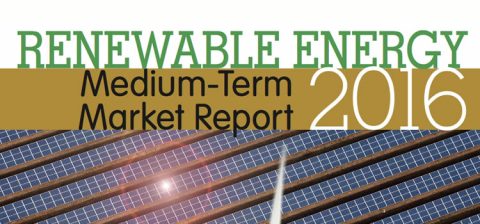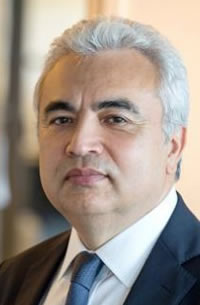
IEA: ‘Duurzame energie mondiaal forser gegroeid dan verwacht’
25 oktober 2016 – Het Internationaal Energieagentschap (IEA) heeft zojuist een rapport gepubliceerd waaruit blijkt dat in 2015 wereldwijd de duurzame energieopwekking fors gegroeid is, naar nu 23%.
- Verwachting: in 2021 28% van de stroom duurzaam opgewekt
- Vorig jaar wereldwijd half miljoen zonnepanelen per dag
- Vorig jaar in China ieder uur twee windturbines
- IEA stelt de verwachtingen voor komende vijf jaar naar boven bij.
Uit een bericht van het IEA
 ‘(…) The International Energy Agency said today that it was significantly increasing its five-year growth forecast for renewables thanks to strong policy support in key countries and sharp cost reductions. Renewables have surpassed coal last year to become the largest source of installed power capacity in the world. The latest edition of the IEA’s Medium-Term Renewable Market Report now sees renewables growing 13% more between 2015 and 2021 than it did in last year’s forecast, due mostly to stronger policy backing in the United States, China, India and Mexico. Over the forecast period, costs are expected to drop by a quarter in solar PV and 15 percent for onshore wind.
‘(…) The International Energy Agency said today that it was significantly increasing its five-year growth forecast for renewables thanks to strong policy support in key countries and sharp cost reductions. Renewables have surpassed coal last year to become the largest source of installed power capacity in the world. The latest edition of the IEA’s Medium-Term Renewable Market Report now sees renewables growing 13% more between 2015 and 2021 than it did in last year’s forecast, due mostly to stronger policy backing in the United States, China, India and Mexico. Over the forecast period, costs are expected to drop by a quarter in solar PV and 15 percent for onshore wind.
Last year marked a turning point for renewables. Led by wind and solar, renewables represented more than half the new power capacity around the world, reaching a record 153 Gigawatt (GW), 15% more than the previous year. Most of these gains were driven by record-level wind additions of 66 GW and solar PV additions of 49 GW.
About half a million solar panels were installed every day around the world last year. In China, which accounted for about half the wind additions and 40% of all renewable capacity increases, two wind turbines were installed every hour in 2015.

“We are witnessing a transformation of global power markets led by renewables and, as is the case with other fields, the center of gravity for renewable growth is moving to emerging markets,” said Dr Fatih Birol, the IEA’s executive director.
There are many factors behind this remarkable achievement: more competition, enhanced policy support in key markets, and technology improvements. While climate change mitigation is a powerful driver for renewables, it is not the only one. In many countries, cutting deadly air pollution and diversifying energy supplies to improve energy security play an equally strong role in growing low-carbon energy sources, especially in emerging Asia.
Over the next five years, renewables will remain the fastest-growing source of electricity generation, with their share growing to 28% in 2021 from 23% in 2015.
Renewables are expected to cover more than 60% of the increase in world electricity generation over the medium term, rapidly closing the gap with coal. Generation from renewables is expected to exceed 7600 TWh by 2021 — equivalent to the total electricity generation of the United States and the European Union put together today.
But while 2015 was an exceptional year, there are still grounds for caution. Policy uncertainty persists in too many countries, slowing down the pace of investments. Rapid progress in variable renewables such as wind and solar PV is also exacerbating system integration issues in a number of markets; and the cost of financing remains a barrier in many developing countries. (…)
The IEA also sees a two-speed world for renewable electricity over the next five years. While Asia takes the lead in renewable growth, this only covers a portion of the region’s fast-paced rise in electricity demand. (…)
The IEA report identifies a number of policy and market frameworks that would boost renewable capacity growth by almost 30% in the next five years, leading to an annual market of around 200 GW by 2020. This accelerated growth would put the world on a firmer path to meeting long-term climate goals.
“I am pleased to see that last year was one of records for renewables and that our projections for growth over the next five years are more optimistic,” said Dr. Birol. “However, even these higher expectations remain modest compared with the huge untapped potential of renewables. The IEA will be working with governments around the world to maximize the deployment of renewables in coming years.” (…)’
Transport en verwarming lopen achter
Uit een bericht van het FD
‘(…) Ondanks de groei moet op de langere termijn meer worden gedaan om ervoor te zorgen dat de opwarming van de aarde ruim onder de twee graden Celsius blijft, de doelstelling van het vorig jaar in Parijs gesloten klimaatakkoord. De verduurzaming van elektriciteit ligt vooralsnog op schema, maar dat geldt niet voor de sectoren transport of verwarming, zo waarschuwt het IEA.
Bovendien verloopt de verduurzaming van de energieopwekking wereldwijd in een ongelijk tempo. De vraag naar energie in China groeit zo hard dat de nieuwe windmolens en andere duurzame bronnen slechts de helft van de nieuwe vraag op kunnen vangen. De rest komt daar nog altijd van fossiele brandstoffen, voornamelijk steenkool. In Europa, de VS en Japan groeit het aanbod duurzame elektriciteit juist harder dan de totale vraag. (…)’
Bronnen
IEA, 25 oktober 2016: IEA raises its five-year renewable growth forecast as 2015 marks record year
IEA, rapport, 25 oktober 2016: Medium-Term Renewable Market Report (pdf, 282 pag., single user € 80)
Summary (pdf, 9 pag., kosteloos)



